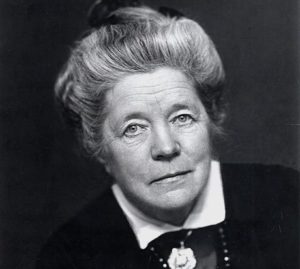We have decided to create the most comprehensive English Summary that will help students with learning and understanding.
The Rattrap Summary in English by Selma Lagerlof
The Rattrap by Selma Lagerlof About the Author
Selma Lagerlof (20 November 1858 – 16 March 1940), a Swedish writer, was the first female to win a Nobel Prize in literature in 1909. Her most remembered book is ‘The Wonderful Adventures of Nils’. Initially a teacher, in 1895, she devoted herself completely to writing. She wrote several books, including novels and collection of stories such as Gosta Berling’s Saga, Invisible Links and The Miracles of the Antichrist.
| Author Name | Selma Lagerlof |
| Born | 20 November 1858, Marbacka, Sweden |
| Died | 16 March 1940, Marbacka, Sweden |
| Profession | Writer, Teacher |
| Movies | The Enchanted Boy, The Saga of Gosta Berling |

The Rattrap Introduction to the Chapter
‘The Rattrap’ is a story that gives us a psychological insight into human nature. The author highlights how greed for material things entraps human beings. The story upholds the belief that the essential goodness of a human being can be awakened through love and understanding. It brings into focus the idea that the world is a rattrap. Riches, joys, shelter and food are all lucrative baits to trap mankind.
The Rattrap Theme
The chapter, ‘The Rattrap’ covers the theme of the basic human need for companionship, and shows the negative effects of loneliness. The story stresses on the fact that most human beings are prone to fall into the trap of material benefit. The author targets the materialistic approach of the people. The worldly riches have disillusioned them, and they are running after the things which are temporary.
The Rattrap Summary in English
The story begins like a fairy tale. The central character is a beggar and a petty thief who goes about selling rattraps of wire to make a small living. He finds it difficult to make both ends meet. It makes him reflect about his own condition and the world at large. He realises that the whole world is nothing but a big rattrap. It offers rich and varied baits to people who bite on them and get trapped in the rattrap.
The storyline unfolds gradually with the various baits being offered to the beggar. The old man that the tramp meets is generous with his hospitality but the bait of the three ten-kronor bills is enough to tempt him. Next at the Ramsjo ironworks, while seeking shelter for the night, the tramp bites the bait offered to him by the owner (though he initially refuses it), the ironmaster, of mistaken identity. Edla, the ironmaster’s daughter, offers yet another bait of full-hearted generosity, comfortable living and a magically peaceful Christmas for the tramp. Finally, the bitter truth dawns on the hosts.
Edla is downcast when she learns that the peddler is a thief. The tramp undergoes a change of heart after experiencing her kindness. He returns the stolen money and writes a letter to her, thanking her for helping him escape the rattrap. He attains nobility of spirit and ‘becomes’ Captain Von Stahle. The story ends with the victory of human goodness.
The Rattrap Main Characters in the Chapter
The peddler
He is the protagonist and central character of the story. He is an unnamed man who lives as a tramp wandering the countryside and selling rattraps. As he does not make enough money from this to survive, the rattrap peddler also engages in petty thievery and begging.
Characteristics of peddler: Vagabound, thief, beggar, witty, philosopher, pragmatist and humorous.
Edla Willmansson
Edla is the daughter of the ironmaster. He is described as ‘not at all pretty, but modest and quite shy’. She is exceptionally kind. She convinces the peddler to come to her house and then convinces her father to let the peddler stay for Christmas Eve. She is the most positive figure in the story, and her compassion and generosity are the reasons for the peddler’s transformation.
Characteristics of Edla Willmansson: Kind, compassionate, friendly, charming, modest, shy, persuasive, sensitive, understanding, hospitable, honest and innocent.
Ironmaster
Ironmaster is Edla Willmansson’s father and the man who owns Ramsjo Ironworks. He is a very prominent ironmaster. He steps by at his forge every day and night to watch the work, and inspects the quality of his products. In his younger days, he was in the military, so he mistakes the peddler for his ‘old regimental comrade’ Captain von Stahle.
Characteristics of Ironmaster: Greedy, cautious, hospitable, suspicious, unkind and taskmaster.
The Crofter
This is an old man who lets the peddler spend the night at his house. As the old man is lonely, he is glad to have a company and provides the peddler with food, tobacco and conversation. He is a very kind, and generous old man, but the peddler repays his generosity by stealing thirty kronors from him.
Characteristics of Crofter: Lonely, happy, friendly, gullible, generous and hospitable.
The Rattrap Summary Reference-to-Context Questions
Read the extracts given below and answer the questions that follow.
1. He had naturally been thinking of his rattraps when suddenly he was struck by the idea that the whole world about him – the whole world with its land and seas, its cities and villages – was nothing but a big rattrap. It had never existed for any other purpose than to set baits for people.
a. Who is ‘he’ here?
Answer:
Here, ‘he’ is the peddler.
b. What was ‘he’ thinking?
Answer:
‘He’ was thinking about his rattraps.
c. What idea was struck to him suddenly?
Answer:
The idea that the whole world with its land and seas, its cities and villages is nothing but a rattrap, struck him suddenly.
d. According to him, what is the purpose of the world?
Answer:
World being a rattrap, it traps people by offering things that attract us.
2. One dark evening as he was trudging along the road he caught sight of a little gray cottage by the roadside, and he knocked on the door to ask shelter for the night. Nor was he refused. Instead of the sour faces which ordinarily met him, the owner, who was an old man without wife or child, was happy to get someone to talk to in his loneliness.
a. When was he trudging along the road?
Answer:
He was trudging along the road on a dark evening.
b. What did he see on his way?
Answer:
He caught sight of a litde gray cottage by the roadside.
c. Why did he knock the door?
Answer:
He knocked the door to ask shelter for the night.
d. What was the reaction of the old man?
Answer:
The old man was happy to get someone to talk to in his loneliness.
3. The next day both men got up in good season. The crofter was in a hurry to milk his cow, and the other man probably thought he should not stay in bed when the head of the house had gotten up. They left the cottage at the same time. The crofter locked the door and out the key in his pocket.
a. Who is the ‘other man’ here?
Answer:
Here, the ‘other man’ is the peddler.
b. Why was crofter in a hurry?
Answer:
Crofter was in a hurry as he had to milk his cow.
c. What did the other man think?
Answer:
The other man thought that it would be inappropriate to stay in the bed when the head of the house has gotten up.
d. Explain, ‘both men got up in good season’.
Answer:
Both men woke up early on time in the morning.
4. He walked and walked without coming to the end of the wood, and finally he realised that he had only been walking around in the same part of the forest. All at once he recalled his thoughts about the world and the rattrap. Now his own turn had come. He had left himself befooled by a bait and had been caught.
a. Who is ‘he’ here?
Answer:
Here, ‘he’ is the peddler.
b. What was he doing in the woods?
Answer:
He was walking and walking in search of an end to the forest, but he was lost.
c. What did he realise then?
Answer:
He realised that he had been walking around in the same part of the forest.
d. ‘Now his own turn had come’. Explain.
Answer:
As he recalled his thoughts about the world and the rattrap, he understood that now he has been caught in a trap for getting fooled by a bait.


